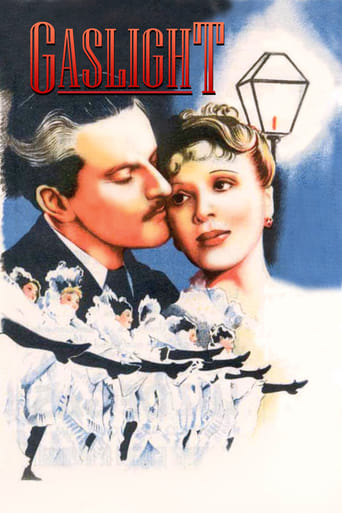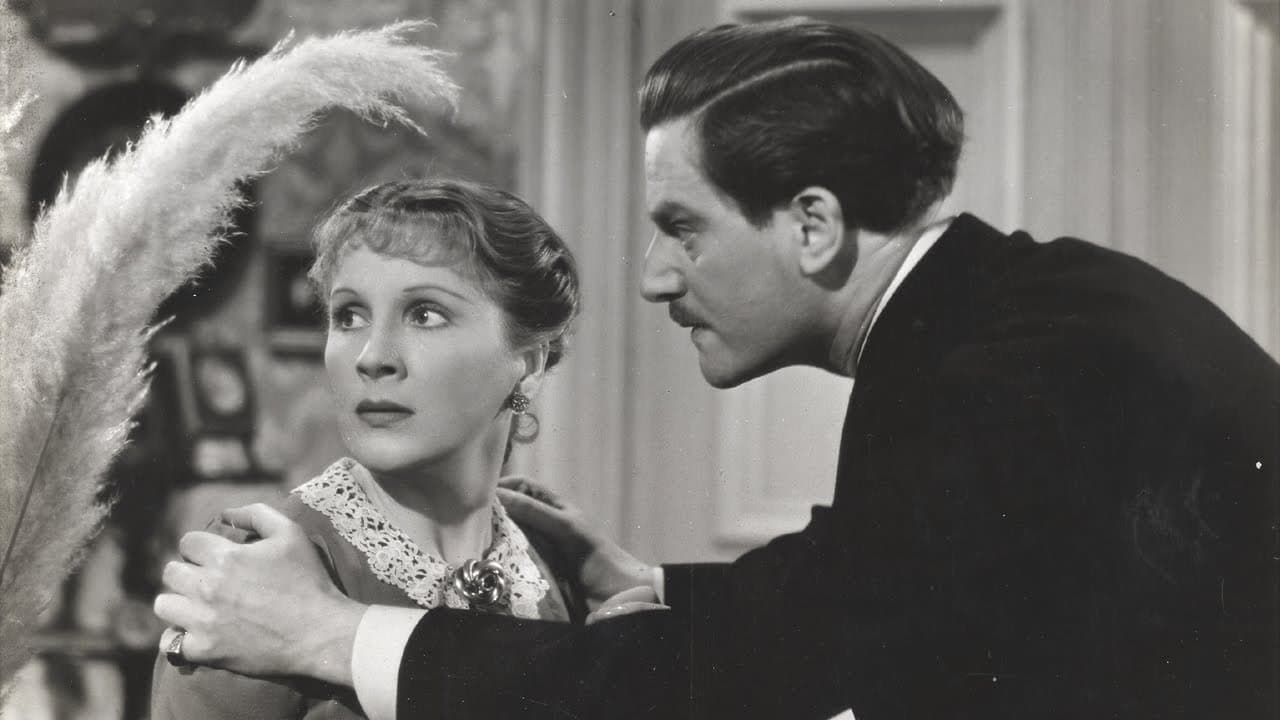Alex da Silva
Psycopath Anton Walbrook (Paul) is after something at 12 Pimlico Square. His wife Diana Wynyard (Bella) is a hindrance and he needs her out of the way, so goes through with a plan to convince her that she is mad and belongs in an institution. However, ex-detective Frank Pettingell (Rough) recognizes Anton from his past and is determined to find out what he is up to.I've read that MGM tried to destroy all copies of this film so that their 1944 remake would be the definitive version. Thank goodness they failed. This film is just as good as the re-make. It has some subtle differences and the cast are excellent – apart from the servant Cathleen Cordell (Nancy) who seems to grin inanely for no purpose on a couple of occasions. Her suitor Jimmy Hanley (Cobb) speaks like a plonker at the beginning but is forgiven, and Frank Pettigell gives the whole story someone to root for as the saviour. He has no romantic interest, he just acts as a kind of Sherlock Holmes who is solving a mystery.There are good scenes and settings and we have a gripping climax when Wynyard turns the tables on Walbrook at the end. Is she going to get even? And check out the can-can dancers. An entertaining film.
James Hitchcock
Even in the UK, this British version from 1940 of Patrick Hamilton's play is less well known than the American version with Charles Boyer and Ingrid Bergman from four years later. The reason, apparently, is that when MGM purchased the rights to film the play, the contract included a clause that the earlier film should be taken out of circulation. MGM even attempted to destroy all copies of the negative, and so "Gaslight"nearly joined the long list of movies from the thirties and forties which are now considered "lost films", but fortunately at least one copy must have survived.The film is set in Victorian London. In the opening scene a wealthy old lady named Alice Barlow is murdered. The murderer is never caught, and after her death the house remains empty for about twenty years until a married couple named Paul and Bella Mallen move in. The marriage is not a happy one and Paul is a bully who treats his wife badly. Bella, who is attempting to recover from a nervous breakdown, begins to fear that she is losing her sanity when she starts hearing mysterious noises coming from the closed off upper floors and when she is unable to remember where she placed various objects. It transpires that Paul is playing psychological tricks on his wife, hoping to drive her mad. (He has a sinister reason for wishing to do such a thing). The significance of the title is twofold. The first that it evokes a sense of nostalgia for the gas-lit London of the Victorian past. The second is that the dimming of the gaslights in Bella's home is an important plot point.This version has some similarities to the work of Alfred Hitchcock. (Hitchcock was later to make "Rope", another film based upon a Hamilton play, and "Suspicion", another film about a wife who comes to believe that her husband may have malign intentions towards her). Whereas Charles Boyer's character in the 1944 adaptation was outwardly charming and plausible, Anton Walbrook's Paul is a much more obvious villain, only bothering to hide his villainy beneath the thinnest veneer of gentlemanly charm. There are some similarities between Walbrook's character here and one of his best known roles, Boris Lermontov in "The Red Shoes". Lermontov is a cold, domineering bully whose bullying has a disastrous effect on Victoria, the heroine of that film, although there is an important difference between him and Paul, an evil figure who quite deliberately plans to cause psychological harm to his wife. Lermontov, by contrast, does not intend to cause any harm to Victoria, and is oblivious to the damage that he is doing. Diana Wynyard's Bella is similar to some Hitchcock heroines, especially the characters played by Joan Fontaine in "Rebecca" and "Suspicion" who initially seem weak and passive but later reveal hidden strengths of character.It is a long time since I last saw the MGM version, so I will not attempt to compare the merits of the two films. This version was made by Thorold Dickinson, a well-known director in his day but largely forgotten today, possibly because he was never discovered by Hollywood in the way Hitchcock was and made all his films in Britain (apart from his final one, made in Israel). He also retired from making feature films at a comparatively young age and spent the rest of his career first working for the United Nations and then as an academic, becoming Britain's first Professor of Films. His version of "Gaslight", however, is a very effective suspense thriller, and the skill with which he handles his material, keeping the audience on the edge of their seats until the end, suggests that he deserves to be better known today. 7/10
Martin Teller
This really isn't a bad movie, it's just that the remake improves on it in almost every way. A full half hour shorter, it begs the question: is it better to slowly build tension, or cut to the chase? While I didn't particularly mind that the entire courtship between the husband and wife was missing (i.e., most of the first act) I did feel like this was a little too rushed, getting straight to the beats of the plot without building that sense of dread and helplessness. Another thing the remake does (and I have no idea what the original text is like) is give the husband much better motivation to marry the woman in the first place. As for the casting, between Charles Boyer and Anton Walbrook, I'll call it a draw. Maybe even a slight edge to Walbrook, who seems a little bit nastier. Diana Wynyard is okay, but no match at all for Ingrid Bergman. Bergman just has a far more compelling screen presence, especially in the finale. Frank Pettingell vs. Joseph Cotten is a trickier comparison, because the characters are completely different. I think I like the character more in the original, but the performance more in the remake. Is it unfair to make these comparisons, particularly since this one came first? Yes, but I can't help it. One version is far more well-known and well-regarded, and for good reason. Again, not a bad movie, but the 1944 version does it so much better, and leaves little reason to watch this one.
Spikeopath
Gaslight is directed by Thorold Dickinson and co-written by A.R. Rawlinson and Bridget Boland, who adapt from Patrick Hamilton's play Gas Light (1938). It stars Anton Walbrook, Diana Wynyard, Frank Pettingell, Cathleen Cordell and Robert Newton. Music is by Richard Addinsell and photography by Bernard Knowles.Alice Barlow is murdered in her home by an unknown man, who proceeds to ransack the house looking for some valuable rubies belonging to the deceased. After sitting empty for years, Alice's house finally gets new owners, Paul (Walbrook) and Bella (Wynyard) Mallen. Not long after moving in Bella finds she may be losing her mind as she keeps misplacing things, hiding objects, imagining strange noises upstairs and convincing herself that the gaslights are weirdly dimming. All is not as it seems in this part of Pimlico Square
. Not as famous as MGM's more glossy version released in 1944, this is, however, every bit the equal of the Ingrid Bergman Oscar grabber. Though stories of MGM to burning the negatives of this film have over the years been embellished, it's true that they did all they could to suppress the release of the film in America. Thing is, they needn't have worried, for Dickinson's film is a very British piece anyway, certainly you feel that their own American produced version would still have had the same popularity that it ultimately had. Dickinson's film is a period melodrama dealing in psychological manipulation whilst casting a roving eye over the British class system in place at the time. There's also a caustic glance at the woman's place in the home, here poor Bella (Wynyard wonderfully correct in portrayal) just wants to be a good wife and be friendly in the neighbourhood, but her life as written is one defined by pure male dominance. This lets in Walbrook, who excels as Paul, ice cold, suave, sinister and effectively calm, you have to ask, what the hell did Bella see in this guy in the first place? Mood is always on the edge of unease, as Bella's mind starts to unravel and with the oppression that comes with the film mostly being set in this one London square, Gaslight starts to gnaw away at the senses. Knowles' monochrome photography dallies in ominous shadows, neatly cloaking the excellent sets in a menacing sheen, and Dickinson (The Arsenal Stadium Mystery) has a gift for tonal pacing and camera work that's not unlike a certain Mr. Hitchcock.It's not perfect, secondary characters could have done with more flesh on the bones and Addinsell's music doesn't always hit the right atmospheric notes. But small moans aside, this is still a fine exponent of the period thriller drama. 8/10


 AD
AD




